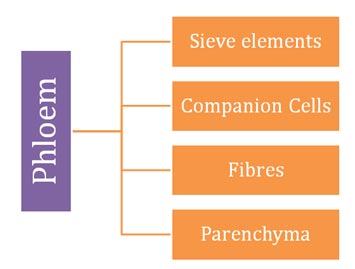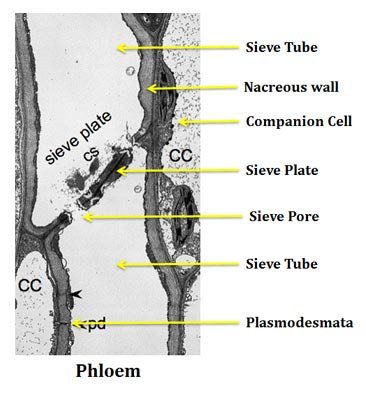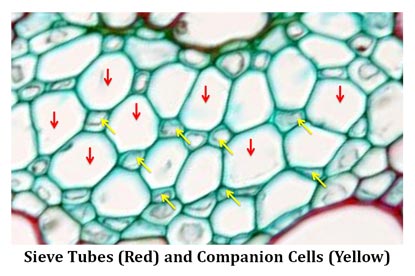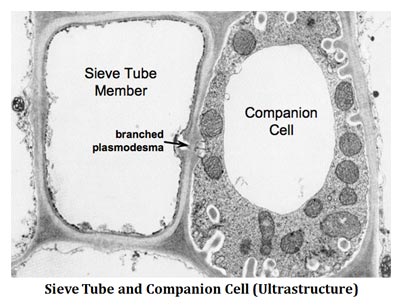Phloem is a complex tissue system in plants. It is the food conducting tissue of vascular plants. Together with xylem, they form the vascular tissue system. The phloem composed of several types of cells among which some are living cells and some are dead. The term ‘phloem’ was introduced Nageli (1853) from a Greek word ‘phloios’ meaning ‘bark’. The ‘bark’ is a non-technical term describing all tissue outside the secondary xylem of the plant. Botanically the bark includes secondary phloem, cortex, primary phloem and periderm. The current post describes the structure, composition, classification and components of phloem.
Location of phloem in plants
Ø Usually, the phloem is situated external to xylem.
Ø In leaves, the phloem is located on the abaxial side (lower side).
Ø In some plants (members of Cucurbitaceae and Convolvulaceae), the phloem is present on both external and internal to xylem. Such a vascular bundle is called bicollateral vascular bundle.
Ø Phloem present internal to the xylem is called ‘internal phloem’ or intra-xylary phloem.
Ø Phloem located external to the xylem is called ‘external phloem’.
Ø When the phloem is seen as included inside the secondary xylem, as occurs in some climbers, it is called as Inter-xylary phloem or included phloem.
Ø The included phloem may be or two types.
(1). Concentric included phloem: included phloem occurs as concentric rings in secondary xylem (xylem and phloem rings alternate).
(2). Foraminate included phloem: Phloem appears as radial strands in the secondary xylem.
What are the components (cell types) of phloem?
Ø Phloem is a complex tissue, composed of FOUR types of cells (phloem elements)
Components of Phloem
(1). Sieve elements
(2). Companion cells
(3). Phloem parenchyma
(4). Phloem fibres and Sclereids
Ø In some plants, in addition to the above mentioned cell types, the phloem also have internal secretary tissues such as Laticifers (Hevea) and resin canals.
 (1). Sieve elements
(1). Sieve elements
Ø Sieve elements are the fundamental cell type in the phloem.
Ø They are the food conducting cells in the phloem.
Ø They are living cells in the phloem with protoplasm.
Ø Nucleus is absent in the sieve elements
Ø Lignified secondary cell wall is absent in sieve elements.
Ø Two types of sieve elements are found in the phloem, they are:
(A). Sieve cells
(B). Sieve tubes
(A). Sieve cells
Ø Sieve cells are less specialized and primitive type of sieve elements.
Ø They occur in the phloem of Pteridophytes and Gymnosperms.
Ø They are absent in Angiosperms.
Ø They are elongated cells with steep inclined end walls.
Ø The sieve areas are located on the lateral wall of sieve cells.
Ø Very rarely the end wall also possesses sieve areas.
(B). Sieve tubes
Ø They are advanced type of sieve elements.
Ø They occur in the phloem of Angiosperms.
Ø They are longitudinal series of cells connected one above the other.
Ø Each cell is called sieve tube member or sieve tube element.
Ø In sieve tubes, the sieve area is located on the end wall called sieve plate.
Ø The sieve area in sieve tubes is more specialized and advanced than sieve cells.
Ø The end wall of sieve tubes may be inclined to transverse in their arrangement.
Structure of sieve tube elements
Ø Sieve tubes are with primary cell wall only.
Ø However, the cell wall much thicker than simple parenchyma.
Ø The cell wall appears as very thick and shining in cross sections.
Ø Due to the shining appearance of the cell wall, they are called as necreous layer.
Ø Nacreous wall consists of cellulose and pectic substances as lamellate structures.
Ø They do not contain lignin in their wall.
Ø The wall area of sieve tube with pore is called sieve area.
 Ø Adjacent sieve tubes are interconnected by cytoplasmic strands through the pores.
Ø Adjacent sieve tubes are interconnected by cytoplasmic strands through the pores.
Ø The sieve pores are comparable with primary pit fields on the parenchymatous cells.
Ø The width of sieve pore may reach up to 15 µ.
Ø Wall portion bear highly specialized sieve area is called sieve plate.
Ø The sieve plate is similar to the perforation plates in xylem vessels.
Ø Two types of sieve plates occurs in phloem:
Simple sieve plate: a sieve plate with single sieve area
Compound sieve plate: a sieve plate with many sieve area
Ø Surface of sieve area looks like a depression with numerous dots.
Ø The dots are protoplasmic materials which pass through pores called pore contents.
Ø The cell wall areas between pore are called ‘bars’.
Ø Each pore is lined with a specialized carbohydrate called callose.
Ø During the ageing of sieve tubes, excessive deposition of callose takes places.
| You may also like NOTES in... | ||
|---|---|---|
| BOTANY | BIOCHEMISTRY | MOL. BIOLOGY |
| ZOOLOGY | MICROBIOLOGY | BIOSTATISTICS |
| ECOLOGY | IMMUNOLOGY | BIOTECHNOLOGY |
| GENETICS | EMBRYOLOGY | PHYSIOLOGY |
| EVOLUTION | BIOPHYSICS | BIOINFORMATICS |
Cell content of sieve tubes
Ø The cells of sieve tubes undergo many changes during development and maturation.
Ø Nucleolus of the cell degenerates.
Ø Endoplasmic reticulum becomes smooth and regenerates into stacks.
Ø By the end of the maturation, ER completely disorganizes.
Ø Dictyosomes and ribosomes in the cells disappear.
Ø Only plastids and mitochondria are retained in the cells as cell organelles.
Ø Two types of plastids are seen in the sieve tubes:
Ø One type of plastids accumulates starch as small grains.
Ø The other type of plastids accumulates plenty of proteins.
Ø Sieve tube plastids have taxonomic significance and have used in solving taxonomic disputes.
Ø Plasmodesmata are present in the sieve tubes for cell to cell communications.
Ø The tonoplast (membrane of vacuoles) disappears during the maturation of sieve tubes
Ø Sieve elements have proteinaceous substances called P-proteins (phloem specific proteins)
Learn more: What are P-proteins and what are its functions in the phloem?
Structure of sieve tubes in relation to function
Ø Structure of sieve tube is well adapted for the translocation of carbohydrates and organic materials.
Ø Sieve tubes elements are connected by protoplasmic contents through sieve pores.
Ø An uninterrupted continuity of protoplasts occurs between cells.
Ø Content in phloem are translocated through cytoplasmic streaming movement
 (2). Companion cells
(2). Companion cells
Ø Companion cells are specialized parenchymatous cells associated with the sieve tubes of Angiosperms.
Ø Sieve tube member and companion cell arise from common mother cell.
Ø Number of companion cell per sieve tube member varies (one to many).
Ø Companion cells are narrower than sieve tube elements.
Ø Companion cells are thin walled cells with only primary cellulosic cell wall.
Ø They contain a large and prominent nucleus.
Ø They connect to sieve tube elements through plasmodesmata.
Ø They contain many plastids and ribosomes.
Ø Companion cells are metabolically very active.
Ø Physiologically it is associated with sieve tube members
Ø Companion cells provide energy to sieve tube elements for phloem transport.
Ø Companion cells are absent in lower plants (Pteridophytes and Gymnosperms).
Ø In Conifers and Ginkgo some phloem parenchyma cells are closely associated with sieve cells.
Ø These cells are called albuminous cells.
Ø There is no ontogenic relationship between albumious cell and sieve tube cells (they are NOT originated from a common mother cell)

(3). Phloem parenchyma
Ø Parenchyma occurs in both primary and secondary phloem.
Ø They are thin walled cells with protoplasm and nucleus.
Ø They have primary pit fields on their cell wall.
Ø Some parenchyma cells in the phloem can store starch as grains.
Ø Two types of parenchyma occurs in secondary phloem:
Ø Axial parenchyma
Ø Ray parenchyma
(a). Axial parenchyma
Ø Axial parenchyma is originated from the elongated fusiform initials of the cambial cells.
Ø They are arranged parallel to the long axis of the organ in which they occur.
(b). Ray parenchyma
Ø Ray parenchyma originated from the ray initials of the cambium.
Ø There are two types of ray parenchyma in the phloem.
A. Procumbent ray cells: long axis of the cell are radially elongated
B. Upright ray cells: long axis of the cell vertically elongated
(3). Phloem Fibres and Sclerenchyma
Ø They are dead cells.
Ø Possess lignified secondary cell wall.
Ø They have simple or slightly bordered pits on their wall.
Ø Septate fibres occur in the phloem of Vitis (Grapes).
Ø In some plants, phloem fibres are very long.
Ø Phloem fibres are also called as bast fibres.
Ø They are long, soft and silky in appearance, hence have immense economic importance
Classification of Phloem
Based on the origin, two types of phloem occurs
(A). Primary Phloem
(B). Secondary Phloem
(A) Primary Phloem
Ø Primary phloem is developed from pro-cambium.
Ø It is developed as part of the primary growth of the plant.
Ø Two types of primary phloem
(a). Proto-phloem
(b). Meta-phloem
(a). Protophloem
Ø Protophloem is the first formed phloem in the plants
Ø During development, sieve elements are stretched and become non functional
Ø Sieve elements of protophloem are narrow and elongated
Ø May or may not have companion cells
Ø Sometimes they may differentiate into fibres
(b). Metaphloem
Ø Metaphloem is developed after protophloem.
Ø It matures after the organs which bear complete their elongation.
Ø Metaphloem is the only food conducting tissue in some plants (herbs)
Ø Metaphloem disorganized after secondary growth.
Ø Metaphloem elements are with well differentiated sieve areas.
Ø Usually fibres do not occur in metaphloem.
Ø Sometimes parenchyma cell becomes sclerenchymatous.
Learn more: Difference between Protophloem and Metaphloem
(B). Secondary phloem
Ø Formed from vascular cambium during the secondary growth of the plant.
Ø Secondary phloem fibres form the bast fibres in some plants.
Ø In Hevea brasiliensis, the latex is obtained from the secondary phloem.
Function of Phloem
Ø Conduction of food materials
Ø Phloem fibres provide mechanical support
Ø Ray parenchyma in the phloem can store ergastic substances
Ø Phloem fibres are source of bast fibres
| You may also like... | ||
|---|---|---|
| NOTES | QUESTION BANK | COMPETITIVE EXAMS. |
| PPTs | UNIVERSITY EXAMS | DIFFERENCE BETWEEN.. |
| MCQs | PLUS ONE BIOLOGY | NEWS & JOBS |
| MOCK TESTS | PLUS TWO BIOLOGY | PRACTICAL |
You may also like…

lot of thanks